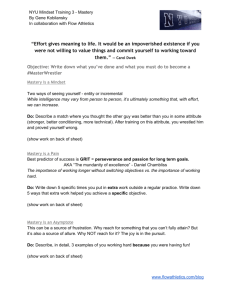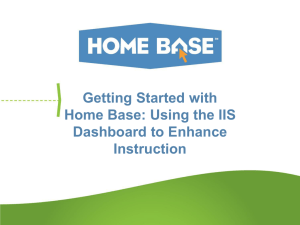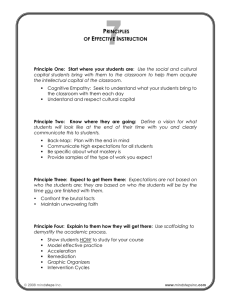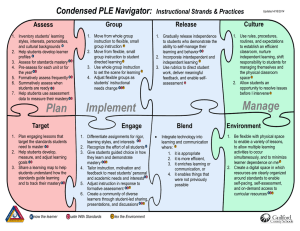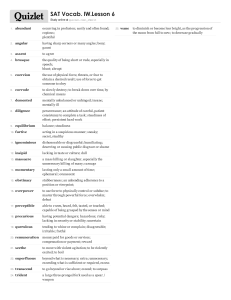The Other Four Disciplines Integrated Lean Six Sigma Solutions Breakfast: Systems Building
advertisement
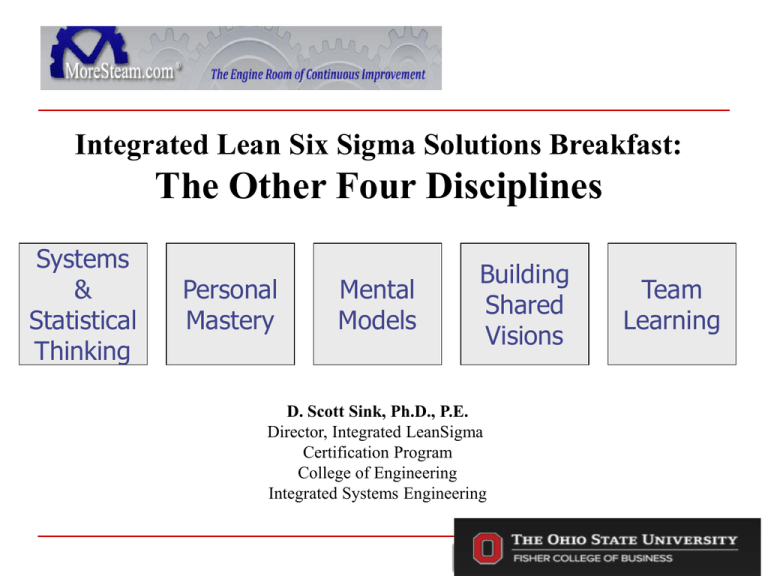
Integrated Lean Six Sigma Solutions Breakfast: The Other Four Disciplines Systems & Statistical Thinking Personal Mastery Mental Models Building Shared Visions D. Scott Sink, Ph.D., P.E. Director, Integrated LeanSigma Certification Program College of Engineering Integrated Systems Engineering Team Learning D. Scott Sink Integrated LeanSigma Certification Program Director, Integrated Systems Engineering, The Ohio State University My Experience and Data Base Education and Professional Experience Academic / Institutions • • • • The Ohio State University, BSISE, 1973 Eastman Kodak, Service Systems Engineer, 1973-1975 The Ohio State University, MSISE and Ph.D., 1978 Oklahoma State University, Associate Professor, 19781984 • Virginia Tech, Full Professor, 1984-1997 • VP, Business Process Improvement (BPI), Exchange Solutions (2000-2004) and MDS (2004-2007) • Executive Consultant for/with David Poirier at Loblaws, HBC, Noske Kaeser, Sears Canada (1991-2012) Industry/Consulting Areas of Interest Business Process Reengineering, Large-Scale Organization Transformations, Performance Measurement/Analysis/Improvement, Lean Sigma, Quality and Productivity, Strategic Performance Improvement Planning (strategy and policy deployment), Change Leadership and Management, Management Systems Engineering Scott Sink rejoined OSU as an Executive in Residence in the Fall of 2007. Scott spent 19 years in academia teaching, writing, consulting and leading Quality and Productivity Centers. He ventured out into the private sector in 2000 and led Business Process Improvement programs at Exchange Solutions (Boston/Toronto) and MDS (Toronto). He successfully launched a best in class Lean Sigma program at MDS (globally) from 2004-2007. Scott served as President of IIE in the early 90’s and has been active with IIE his entire career. 2 Additional Experience/Data Base—Council on Industrial Engineering 2006 to present And since 2007 very intensive Experience/Data Base with a variety of very different types of organizations in the Greater Columbus Area 04.12.2013 4 Point being…. I do a lot of benchmarking to: • Op Ex Programs • ILSS blended training • Change Leadership and Management issues and concepts. I think I would characterize the Objective of working on the Other Four Disciplines as… I was recruited to lead the Operational Excellence ‘Plank’ in the MDS Lean Sigma Foundations Enterprise Transformation in 2004 (reported to President of Enterprise Services) Process Business Performance Reviews Talent Management Outcomes Weekly EMT teleconferences Action oriented decision making Monthly business reviews Tighter accountability Disciplined annual plans Customer responsive Better understanding of “A” performers; enriched career path Biannual talent reviews New executive compensation plan Expansion of variable compensation opportunity Alignment of shareholder and management incentives Customer/ Competition/ Capital Operational Excellence Business unit/Corporate strategy Longer range growth agenda Detailed industry analysis Focused R&D investments Customer value led process Capital matched to growth Lean Sigma Roadmaps and Toolkit Standard approach across the Enterprise Compliance Programs (EHS, Quality, etc.) Building global quality competitiveness, productivity improvement, process and cost efficiency, compliance and assurance LeanSigma Practitioner Development Balanced Improvement Portfolios Simplify processes Customer responsive End Game for our Performance Improvement Efforts—Growing Enterprise Value Ideal Average Stakeholder Relationship Duration Full Potential Greater Longevity The ‘End Game’ is to Optimize the Lifetime Value of various stakeholders in the system (customers, internal and external; employees; shareholders; the business) There is a science and there are explicit methods that can be utilized to do this Formalized Performance Improvement Programs (e.g. Op Ex) can have huge impact Blended, broad, balanced views and capabilities on types of improvement methods is required. 1.0 Ideal Average Stakeholder Relationship Value Created Enhanced Behavior 1x 1.0 1.0 Increased Geog. / Segment Scope/ Ideal Quantity of Stakeholder Relationships 7 Our Performance Improvement Efforts should be aimed at aligning to Business Strategies (policy deployment) but clearly in one or more of these three buckets POSITIONING STRATEGY VALUE EXCHANGE OPTIMIZATION 25x OPERATIONAL EXCELLENCE 50x 10x 1x Improve Positioning via.. Managing the Exchange of Value With Stakeholders Geographic Coverage / Offerings Provided / Served Segments / Branding/ Imaging, etc. Altering the Give/Get, Responding to unmet and unfulfilled needs, QFD, Innovation, Rebalancing Segment Investment Improve Quality, Efficiency, Productivity, Innovation, Engagement, Quality of Work life, Sustainability Apply principles and methods of ISE and ILSS The Equation for Success (Possibilities and Drivers) Y (sustainable, bestin-class business results) = f( X (key driver variables) X1: Leadership & Management Alignment and Commitment • 2-3% of Total Enterprise Revenues in Hard Benefits Annually X2: Pick the right ‘belts’ X3: Best-in-class training and development • > $125,000 in Hard Benefits / Project X4: Pick the right projects • Right Size the process improvement and business process improvement specialist pool over time to build capacity to support the required level of improvement in our business plans and objectives. X5: Skillful, disciplined, sustainable execution of LeanSigma Methodology; • 40% of our employees activtely engaged in improvement of what we do and how we do it at any given moment in time X6: Celebrate successes and use them as a catalyst for even more success • X7-n……(e.g. infrastructure, communication front, etc.) 9 ) Program Initialization Engage Celebrate Pick the Best in Discipline Achieving Sustainable Excellence: Lessons we all the And here’s the rub, what Successes to get Right Class around ‘Right’ the ‘fly wheel’ Projects Training Methodology People fromstruggle the ‘Front Lines’ spinning with TBI = Timely Business Impact P= TBI = P * Q * CfS t Pick the Right Belts & Projects Q= Quality of Solution CfS = Conditions for Success and Discipline for Execution & Sustainability Adapted from: Xerox and Making Six Sigma Last by George Eckes t = Cycle Time Program Initialization Engage Celebrate Pick the Best in Discipline Achieving Sustainable Excellence: Lessons we all the And here’s the rub, what Successes to get Right Class around ‘Right’ the ‘fly wheel’ Projects Training Methodology People fromstruggle the ‘Front Lines’ spinning with Other Four Disciplines Systems & Statistical Thinking Personal Mastery Mental Models Building Shared Visions Team Learning Overall Performance Improvement that comes with Lean and SixSigma systematically focused on business process improvements The discipline that is the easiest Systems & Statistical Thinking Personal Mastery Mental Models Building Shared Visions Team Learning • DMAIC Roadmap, steps, tools, methods, • Analytics • Bloom’s Taxonomy—practice to mastery, skillfulness • Pick right projects • Program and project management • Measurement and Analytics, etc. ISE + the ‘right’ performance improvement strategy and methods will push ‘levers’ in the EVM and then drive enterprise value growth (every project should map this out) 25x 10x 1x Enterprise Value Map Practical paths to increase shareholder value Sigma Foundations Fix a Process DMAIC;Lean Build/Reengineer a Process DCDOV Product (System, subsystem or part) Problem Solving Development Or Problem Solving? Development Tools, content, etc. Identify Design No Optimize Validate IDOV 04.12.2013 Process Does Process Exist? Yes Define Define Measure Measure Analyze Analyze Goals achieved with existing design? Goals achieved with existing process? Yes Tools, Toll gate content, etc. Process Or Product? Define Measure/ Concept Design/ Explore No Yes Improve Improve Control Control No Augmented DMAIC Classic DMAIC Detailed Design/ Develop Optimize/ Implement Verify DCDOV/ 14 DMEDI DMAIC Roadmap Drives Creation of Value Belts have to do the whole triangle on their projects • Foundational data role – Select and gather data from many sources, preferably through automated extract, transfer, & load (ET&L) process – Assure data are cleaned & ready for analysts to use – data quality monitors – Assure data are integrated & can be joined with other data – think LEGOs – Assure data storage is high reliability & user-friendly – SSAS cubes, databases • • • In the current state process, we split data and analytics Data are stored in a common place, and are trusted and available “Above the line” analyst role – Extract features from data through statistical analyses – Apply business acumen to data & analyses – create new knowledge – Apply data visualization techniques to aid in telling the right story – as in life, so in business: the best story wins … S. Cunningham; Intel Corporation; 2013 And the hardest part is the top two rows, the art aspect of analytics Feature extraction – JMP, SAS, S+, R for basic statistics – Emerging apps in ‘big data’ – Hadoop, Apache, etc. Knowledge extraction – In supply chain, this is not about the software tool, but rather smart people – In our experience, people are best at spotting patterns – so far … Visualization • • The people you put ‘above the line’ will make or break your analytics program There are some great, innovative, & truly modern tools ‘above the line’ – Great tools: Tableau, BOBJ, MS BI – We believe strongly in the investment in software and training here – At the end of the day, this is what makes the work memorable … S. Cunningham; Intel Corporation; 2013 Program Initialization Engage Celebrate Pick the Best in Discipline Achieving Sustainable Excellence: Lessons we all the And here’s the rub, what Successes to get Right Class around ‘Right’ the ‘fly wheel’ Projects Training Methodology People fromstruggle the ‘Front Lines’ spinning with Other Four Disciplines—the hardest Systems & Statistical Thinking Personal Mastery Mental Models Building Shared Visions Speed of Trust Team Learning The Intended Outcome—READINESS Create Change Masters 1991-2011: Real World (23-60 something) • 50 or so, 3-5 day ‘boot camps’ integrating O4D with Value Stream Workshops 2007-present: Academia (0-22 World) • 10, 1 day labs plus 13-40 weeks of reinforcement Readiness to effectively and actively engage in, participate in, support change and improvement. Readiness to effectively LEAD and successfully create change and improvement. SEASONING ISE Undergraduates TO MAKE Quicker, Bigger/Better CONTRIBUTIONS Integrated Change Leadership & Management: Senge’s Five Disciplines: ISE & Integrated Lean Sigma WITH Shared Vision/Creation Skillful, Mental Models, Team Learning, Personal & Professional Mastery Soph/Jr. (‘composite’ Profile) ILSS CERTIFICATION PROGRAM PERSONAL MASTERY • don’t listen well • Action junkies • don’t stay focused, can’t juggle multiple balls well • don’t communicate well • victim behavior • judgment mode common • Parent-child lingering, still, with TeacherStudent, which will carry over to boss to subordinate if not corrected 2 Semester, Real World Capstone + Black Belt Foundation Course (all five Disciplines) PROFESSIONAL MASTERY • do not exhibit ideal learning behaviors • do not understand what it takes to succeed in the ‘real world’ • struggle mightily to ‘reduce to practice’, sloppy, undisciplined practice • can’t manage projects successfully • do not manage relationships proactively • cannot produce results, lose sight of the endgame • have heard the talk on ‘ethics’ and values + Solid ISE Core Curriculum: OR, HFE, MSE, M/PSE Senior (‘composite’) PERSONAL MASTERY • can deep listen, can active listen, seek to understand • Plan before acting, Context, Possibilities, Action • practiced focus and persistence with something difficult for 6+ months • communication skills (written, oral, body language) enhanced for success • spend less time in judgment more time in evaluation and difference, consciousness about tendencies • made the switch of making the switch to Adult to Adult PROFESSIONAL MASTERY • improved consciousness and practice with ‘ideal learning behaviors’ • clear understanding of ‘flat world’, competitive World requirements for success, more real world savvy • lot’s of opportunities for perfect practice • demonstrated program and project management skill to gain certification • relationship management skill development initialized, understand importance • Capable of producing results in timely fashion and understand them in context of the system or higher good • have had to walk the talk on ethics and values Our Vision Create lifelong relationships built on trust Our Mission We work for Canadian Families: We offer our customers great value through innovative, fashionable and affordable products and services they love. We stand behind our products, prices and services – before, during and after a purchase. We provide memorable experiences at every touch point – be it instore, on-line or on the phone. We create an environment where we respect and value our associates and customers alike. We are an involved member of the community and a careful steward of the environment. Five Waves of Trust • Self • Relationship • Organizational • Market • Societal 4 Cores of Credibility (self trust) First Wave is all about •Integrity •Intent •Capability Second Wave—Relationship Trust is all about consistent behaviors 1. Talk Straight 2. Demonstrate Respect 3. Create Transparency 4. Right Wrongs 5. Show Loyalty 6. Deliver Results 7. Get Better 8. Confront Reality 9. Clarify Expectations 10. Practice Accountability 11. Listen First •Results 12. Keep Commitments 13. Extend Trust Earning Trust will Grow Sears Franchise Value (SxE)T = R Ideal Average Customer Relationship Duration Greater Longevity 1.0 (Strategy x Execution) Trust = Results Ideal 27x Average Customer Profitability Per Year Enhanced Behavior Trust will speed things up for us 1x 1.0 0.2x 1.0 Increased Geog. / Segment Scope Ideal Number of Customer Relationships 26 Private and Confidential BUT, how do we develop Speed of Trust Systems & Statistical Thinking ISE, ILSS, DMAIC, DCDOV, Principles, Methods, Tools, Analytical, Disciplined, Fact/data based, etc. Personal Mastery Personal Mastery-Personal Mastery is the discipline of ‘continually clarifying and deepening our personal vision, of focusing our energies, of developing patience, and of seeing reality objectively Mental Models Building Shared Visions Mental Models--what I look for in this area is how easy are you to work with, are you always creative and thinking about possibilities, or is it a 'fight'/struggle a lot, do you get stuck Shared Vision--extent to which you have been creation skillful, creating a tangible real future state that people are being pulled to rather than it feeling like it's just problem solving Team Learning Team Learning to include relationship management--when I'm in a TG do I get a sense that you have built a solid working relationship, what's the 'culture' of the meeting feel like Performance = f (…….) Effort: Mindset: • Level of Effort • Willingness Performance: • Efficiency • Personal outcome • Intention • Productivity • Focus • Quality of Effort (e.g. grade, bonus, raise, assignment quality, etc.) • Attitude • preparedness • Productivity (output/input) • Values & Ground Rules + Attributes: • ‘connectivity’ Capability: • relationship management • Knowledge/ability • servant mentality • listening skills • Skill • commitment to serve higher good • Competence • consciousness • Experience • astuteness • (IQ) Intelligence Attributes? • Output (deliverables) • image, positioning, likeability • EI (Emotional Intelligence) • Effectiveness (doing right things) • Results (process capability improved, efficiency up, capacity improved, productivity up, etc.) • Impact (Profit and Loss statement impacted positively, balance sheet improved, franchise value growth) Related to the TRUST issue in our Transformation, too much ‘thought, word, deed’ on left side ---IT’S SLOWING US DOWN, EXHAUSTING US!!! Ourselves Conventional Attack Ideas Individual Service to Others Creative Nurture Ideas Team – SERVING Fearful Indecisive Being Popular Focus on Activity Courage Decisive Right Decision Focus on Results – EXCELLENCE Suspicion Blaming Competition Avoidant Accountable Team Collaboration Direct – INTEGRITY Defending Arguing Hierarchical Territorial Learning Listening Empowering Sharing – LEARNING FULL POTENTIAL PERFORMANCE UNDER PERFORMANCE 29 Private and Confidential Ground Rules (or Operating Principles) as a way to Bridge Values to Thought, Word, Deed 1. Be Self Monitoring 2. Maintain an Attitude for Learning 3. (Say what you will do / Do what you say) Create an Environment that brings out the “BEST” in Yourself and Others 6. (Say what you mean / Mean what you say and Communicate with the Intention to Contribute; Confidentiality, no retribution, no attribution, learnings not specifics) Make “Good Agreements” and Keep Them 5. (Hold a 1%Possibility / Look to be creative) Use Open, Honest and Direct Communication 4. (Show up / Stay Conscious / Observer On) Seek to understand Keep the Outcome in Mind (Think like the customer) 30 Working on O4D takes people out of comfort zones Danger Zone High Performance Zone Safe Comfort Zone Fear Increases Fear Decreases 31 Establishing the Values and Ground rules Importance Tackle Fear Factor Confront Comfort Zone issue Position permission Introduce Defensive Routines and how to manage Establish Agreement Management and Breakdown Management Process Get clarity on Roles and Rules - 04.12.2013 - 32 Have to keep revisiting, half life is a week, maybe days Have to get outside your own comfort zone at times to manage this Some additional points on this model 1. Smart people can and will muddle there way through anything. 2. we don’t know what we don’t know, we are often unconsciously incompetent. 3. We don’t know what we need to learn until after we have practiced something. You can speed up the process with a ‘coach’ but most people don’t have mentors, boards, or coaches. One of those conscious or unconscious choices. 4. Human minds don’t work like computers, they aren’t good at understanding cause and effect, particularly over longer periods of time. So the if A then B then C then…….Y (and Y is you lose your job or you die) is hard for people. So we rationalize and get at-effect on situations. 5. To avoid the yield loss from these two conditions, requires humility and living to some ground rules that map to full potential development (see next slide as example) 6. The hardest thing in the world is to get somebody to change their mind. 7. First we make our habits and then our habits make us. • - 04.12.2013 - 33 Program Initialization & Infrastructure Engage the ‘Right’ People Pick the Right Projects Best in Class Training Discipline around Methodology Celebrate Successes to get the ‘fly wheel’ spinning 1. Passion for Improvement, (personally, professionally and organizationally), Operational Excellence, LeanSigma – 2. Intellect, Analytical and Technical Skills for this type of work: 3. Process orientation/Systems Thinking/Creation Skillful/Creative Problem-solver – 4. Business Process knowledge, Content Knowledge – 5. Ability to spend required time – 6. Customer Focus and Creation of Franchise Value orientation 7. Respected by the Organization 8. Training, Coaching, Communication Skills 9. Leadership Values, Core Competencies, Skills 10. Ability to catalyze and cause change through influence 11. Business Acumen, Functional competencies Performance Model Constructs Capability (abilities): to focus, to hold abstractions, to listen and hear other people’s points of view, to see/understand the context of things, to relate things, to visualize outcomes for opportunities, IQ, EQ (EI), etc. This maps to Covey’s Capability Dimension for individual Trust. Capability to conceive of possibilities Less a choice for us, but can be developed. Think of it as our Potential Energy Competence: Skills, actions, reduction to practice, theory to use/in action, development of capabilities, this maps to Covey’s Results Dimension for Individual Trust. Vision Bridging. Result of lots of choices on our part. Think of it as our Kinetic Energy. Someone’s resume. Intention: our ability to create a clear picture of DONE, visioning. This is different than Covey’s intention or intent where I take him to mean ‘agenda’ or why are you doing something. This is more Will but Potential Energy again not kinetic. It is exclusively a choice on our part, it is the ‘attitude’ is a choice relative to our will to get to DONE, Commitment: it’s the degree to which we are able to bring intention to bear, the level of intention we apply, Result of lots of choices on our part. Think of it as our Kinetic Energy. It’s what really builds someone’s resume. The first box is central which is why picking right people is so critical. Then 3 rd and 4th boxes take over and then then really lead to competence. Consolidated ‘top 10” ideal ‘things’ (thought, word, deed) from Row/Front Change Agents • Trustworthy at individual level and at relationship level (integrity, intent, capabilities, proven results), can and do build it fast and can sustain it. – Make Quality Agreements, keep them, if/when breakdowns happen, they are managed in a way that builds trust • Open, Honest, Direct: Managerial Courage, (on the right side of Values Slide for Excellence and Integrity) • Strong Communication Skills, able to engage and get people connected to things. Balance Effective Listening with Effective Communicating. • Business Acumen—savvy, quick to understand systems, processes; quick to understand politics and stakeholders; quick to understand drivers and enablers; quick to assess the situation in context of Deloitte Touche Enterprise Value Map • Intentional, at-cause, bias for results, hard right on Excellence row of Values Chart Consolidated ‘top 10” ideal ‘things’ (thought, word, deed) from Row/Front Change Agents (Continued) • Top of class relationship initiation, building, and sustaining skills with wide variety of segments of people; • Creation Skillful—able to see possibilities and get others to see possibilities (shared vision, future state), also able to vision bridge and help others hold the vision • Change Leadership/Management—style flexibility across all Professional Modes of Functioning (challenger, acceptant listener, coach, collaborator/follower, opinion seeker, data/fact gather and analyzer, etc.) – • Able to live outside comfort zone and get others outside comfort zone and get in growth zone, – Able to not get stuck, to zoom-in and zoom-out – conscious, keeps observer on, doesn’t get trapped in ‘judgment’, doesn’t get positional, able to stay in evaluation and difference stances Fix the System, Fix the Process Orientation with ability to help fix problems but always with the fix the process view of things Consolidated ‘top 10” ideal ‘things’ (thought, word, deed) from Row/Front Change Agents (Continued) • Personal Productivity—works smart, great at start/stop/continue, outstanding time management skills, hard worker, work life balance skills (e.g. Covey’s First Things First), model personal and professional productivity • Best in class Program Management Skills (by definition implies that the individual is a great Project Manager) – – Outstanding at Integrated Master Planning, best in class by definition, again, if you are best in class at IMP then you are solid at the IMS level too (note it’s hard to be great at IMS—integrated master schedules if you aren’t great at IMP. Most people are really average project managers largely because they are terrible at IMP • Mental Models, Paradigms—consciousness, keeps observer on, works with feedback (proactively) incessantly, able to get others to confront paradigms and be open to learning and 1% possibilities, able to spark and catalyze learning organization (people) behaviors • Keeps perspective on things, doesn’t sweat small stuff, keeps sense of humor, has fun and helps others have fun Consolidated ‘top 10” ideal ‘things’ (thought, word, deed) from Row/Front Change Agents (Continued) • Courage to seek help, admit don’t know what don’t know or that you don’t have everything you need to be successful. Proactive, timely management of all requirements for success and encourages others to do same thing. Aware that smart people can muddle their way through anything and that in Turnaround/Transformations you don’t have time for that. True Greatness is not a function of Circumstance, True Greatness is Totally a matter of conscious choice, and discipline. 40 Commitment and Intentionality The Return on Luck Factor Collins Discusses Until one is committed there is hesitancy, the chance to draw back, always ineffectiveness. Concerning all acts of initiative (and creation) there is one elementary truth, the ignorance of which kills countless ideas and splendid plans: that the moment one definitely commits oneself, then Providence moves too. All sorts of things occur to help one succeed that would never otherwise have occurred. A whole stream of events issue from the decision, raising in one’s favour all manner of unforeseen incidents and meetings and material assistance, which no person could have dreamed would have come their way. We are much more likely to act our way into a new way of thinking than to think our way into a new way of acting. Only those who have the patience to do simple things perfectly will acquire the skills to do difficult things easily. • - 04.12.2013 - 41 Personal Mastery and Creation Skillful are the lead ‘fronts’ Systems & Statistical Thinking ISE, ILSS, DMAIC, DCDOV, Principles, Methods, Tools, Analytical, Disciplined, Fact/data based, etc. Personal Mastery Personal Mastery-Personal Mastery is the discipline of ‘continually clarifying and deepening our personal vision, of focusing our energies, of developing patience, and of seeing reality objectively Mental Models Mental Models--what I look for in this area is how easy are you to work with, are you always creative and thinking about possibilities, or is it a 'fight'/struggle a lot, do you get stuck Building Shared Visions— Creation Skillful Shared Vision--extent to which you have been creation skillful, creating a tangible real future state that people are being pulled to rather than it feeling like it's just problem solving Team Learning Team Learning to include relationship management--when I'm in a TG do I get a sense that you have built a solid working relationship, what's the 'culture' of the meeting feel like Different energies in these two Problem-solving: (the predominant paradigm in ILSS) • Making something go away that we have and don’t want. Creation Process: (the predominant paradigm in learning organizations—the Greats!) • Getting clear on what we want and then bringing it into being. If you do the second, resistance to change evaporates! It’s this process for O4D Serving, Learning, Integrity, Excellence What I want, don’t have What I can create What I have, don’t want What I commit too Who I am (BE) What people can count on me for - 04.12.2013 - 44 Personal and Professional Mastery Technical and Change Leadership Problem Solving Integrity and Servant Mentality Metanoia Commitments and Relationship Management What I have and new wants What I can do, create What I have, don’t want Who I am with commitments Who I am (BE) What people can count on me for It’s this process for ILSS and Process Improvement Serving, Learning, Integrity, Excellence What I want, don’t have What I can create What I have, don’t want What I commit too Who I am (BE) Technical and Change Leadership Creation Skillful, Change Management Program and Project Management Breadth and Depth of Tool RTP: VSM/A, SPC, Simulation, MSA, Mistake Proofing, VMS’s, PFMEA (front and back); DOE; What I have and new wants What I can do, create What I have, don’t want Who I am with commitments Who I am (BE) Analytics What people can count on me for EDA and CDA Business Cases Problem Solving, Solve the Focal Problem - 04.12.2013 - 45 What people can count on me for Other components to the O4D Development Process Systems & Statistical Thinking • • • • Personal Mastery Mental Models Building Shared Visions Team Learning Plant seeds with new mental models The 04D Trilogy • Attitude is a Chioce • At-Cause/At-Effect • Intention-Mechanis-Results Relationship Management—Trust Management Style Flexibility through increased self-awareness and understanding 13 things mentally strong people don’t do Mentally strong people have healthy habits. They manage their emotions, thoughts, and behaviors in ways that set them up for success in life. Check out these things that mentally strong people don’t do so that you too can become more mentally strong. 1. They Don’t Waste Time Feeling Sorry for Themselves Mentally strong people don’t sit around feeling sorry about their circumstances or how others have treated them. Instead, they take responsibility for their role in life and understand that life isn’t always easy or fair. Planting new mental models, abstractions in their heads 2. They Don’t Give Away Their Power They don’t allow others to control them, and they don’t give someone else power over them. They don’t say things like, “My boss makes me feel bad,” because they understand that they are in control over their own emotions and they have a choice in how they respond. 13 things mentally strong people don’t do 3. They Don’t Shy Away from Change Mentally strong people don’t try to avoid change. Instead, they welcome positive change and are willing to be flexible. They understand that change is inevitable and believe in their abilities to adapt. 4. They Don’t Waste Energy on Things They Can’t Control You won’t hear a mentally strong person complaining over lost luggage or traffic jams. Instead, they focus on what they can control in their lives. They recognize that sometimes, the only thing they can control is their attitude. 5. They Don’t Worry About Pleasing Everyone Mentally strong people recognize that they don’t need to please everyone all the time. They’re not afraid to say no or speak up when necessary. They strive to be kind and fair, but can handle other people being upset if they didn’t make them happy. 6. They Don’t Fear Taking Calculated Risks They don’t take reckless or foolish risks, but don’t mind taking calculated risks. Mentally strong people spend time weighing the risks and benefits before making a big decision, and they’re fully informed of the potential downsides before they take action. 7. They Don’t Dwell on the Past Mentally strong people don’t waste time dwelling on the past and wishing things could be different. They acknowledge their past and can say what they’ve learned from it. However, they don’t constantly relive bad experiences or fantasize about the glory days. Instead, they live for the present and plan for the future. 13 things mentally strong people don’t do 8. They Don’t Make the Same Mistakes Over and Over Mentally strong people accept responsibility for their behavior and learn from their past mistakes. As a result, they don’t keep repeating those mistakes over and over. Instead, they move on and make better decisions in the future. 9. They Don’t Resent Other People’s Success Mentally strong people can appreciate and celebrate other people’s success in life. They don’t grow jealous or feel cheated when others surpass them. Instead, they recognize that success comes with hard work, and they are willing to work hard for their own chance at success. 10. They Don’t Give Up After the First Failure Mentally strong people don’t view failure as a reason to give up. Instead, they use failure as an opportunity to grow and improve. They are willing to keep trying until they get it right. 11. They Don’t Fear Alone Time Mentally strong people can tolerate being alone and they don’t fear silence. They aren’t afraid to be alone with their thoughts and they can use downtime to be productive. They enjoy their own company and aren’t dependent on others for companionship and entertainment all the time but instead can be happy alone. 12. They Don’t Feel the World Owes Them Anything Mentally strong people don’t feel entitled to things in life. They weren’t born with a mentality that others would take care of them or that the world must give them something. Instead, they look for opportunities based on their own merits. 13. They Don’t Expect Immediate Results Whether they are working on improving their health or getting a new business off the ground, mentally strong people don’t expect immediate results. Instead, they apply their skills and time to the best of their ability and understand that real change takes time. Matthew Kelly and Creation Skillful Dream Manager and Four Levels of Energy dialogue (O4D) • http://www.youtube.com/watch?v=ESxXO42HvDQ Dream Manager • http://www.youtube.com/watch?v=q6RcFY0Tqro Energy Management • http://atworkjax.wordpress.com/2011/10/28/managing-your-energy/ - Level One energy as “low level, negative.” Level One is when you are exhausted, even depressed. - Level Two is “high level, negative,” according to Kelly. At this level, you don’t feel lethargic. On the contrary, you’re fearful, irritated, even angry - Level Three energy is “low level, positive.” You feel content, even mellow. You might be inwardly focused, reflective. Kelly describes it as “restorative;” it’s a good place to recover and rebuild your energy. - Level Four energy “the crown jewel.” It’s “high level, positive energy;” the place where we live our best lives. We are confident, joyful and invigorated. • So, who owns getting and staying in level 4, who controls it? Power of Habits & The R Factor and Mindset Management http://www.focus3organizationalculture.com/ How do you navigate the events of life & work in a way that produces great results? The answer begins with a simple, but powerful equation: E+R=O Event + Response = Outcome The reality is -- you don't control Events & you don't control Outcomes. The only thing you can control is how you choose to Respond. E + R = O is just the way life works. Success goes to those who are able to Manage the R. We call it The R Factor. Your job is to get good at it. O4D Trilogy 1. Attitude is a Choice • • • 2. Stances we can adopt, types of attitudes 3. The attitude I choose/adopt, impacts the results I create the brain has three parts/components, the oldest part tends to take over in certain situations over riding the newest part (where creation and full potential happens) Humans tend to go unconscious at times At-cause At-effect Intention-Mechanism-Result Model (extension of at-cause/at-effect) Stances, examples of attitudes, thought patterns Difference Evaluation (usefulness, utility) Judgment (right/wrong, good/bad, agree/disagree) OR Extension of attitude/stance—two types of stances relative to ‘situations’ At-cause Best case Fix the System Fix the Process Fix the Problem Worst case Do Nothing Best case Enroll Others Sabbotage Worst case At-effect Further extension of at-cause/at-effect, how this plays out in endeavors we apply ourselves to 10 10 INTENTION 0 MECHANISM What might need to happen? • the forecast 0 • the system • the product/offering • coworkers • the professor We Try and hope We create error—results less than planned 100 0 • the project/company RESULTS We tell “Stories” about (Blame) • My team mates What tends to happen Style Flexibility Professional Modes of Functioning: Acceptant Listener Team member, collaborator participant data/fact gatherer opinion seeker opinion giver expert, solution provider challenger structured group process provider - 04.12.2013 - 56 Styles: DeBono’s 6 thinking Hats Myers Briggs Type Indicator etc. Methods: Role Playing Fish-bowl dyadic feedback and trust exercises


